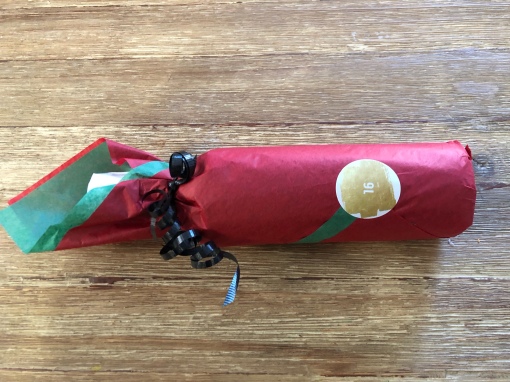By Tyler Derksen
After a bit of a hiccup on Friday (the 13th, so you’d think I would have seen it coming), things quickly got back on track with the Bricks Advent Calendar, and today continues that trend. Over this past weekend, I was speaking with a friend and extolling the virtues of a wine Advent calendar. The obvious benefit is that I get a couple glasses of wine every evening to help me get into the holiday spirit. The other benefit is that the wine world is so varied and this year’s calendar is taking full advantage, allowing for a vast exploration of styles, grapes and regions over a quick 24 days. And so it is that on Day 16, we get to taste yet another classic varietal from a storied wine-making area.

Tonight’s wine is a Nebbiolo from Langhe in Piedmont, Italy. While Barbera and Dolcetto are also grown in Piedmont, the true star of the region is Nebbiolo. The wines made from this grape can vary in style depending on where it is grown, even within Piedmont, but it is the grape from which both Barbaresco and Barolo, true all-stars of Italian wine, are produced. Interestingly, the wines produced in Piedmont are very often single varietals, as compared to much of the rest of Italy where the wines are often blends (much in the same way that Burgundy differs from the rest of France for this same reason). Langhe is a region within Piedmont that itself includes Barolo and Barbaresco. The more general Langhe designation is given to wines that do not adhere to the strict geographical or production requirements of Barolo, Barbaresco or other D.O.C.G. requirements.
La Spinetta, the producer of today’s libation, is one that is well known to me. I was first introduced to the winery when I tried its Bricco Quaglia Moscato d’Asti. Truth be told, I’m not a huge fan of bubbles (aged Champagne excepted of course), and so this was a revelation to me. Inexpensive and low in alcohol, the Bricco Quaglia quickly became my go-to bottle whenever bubbles were needed, and it has become a bottle of choice for my extended family for pre-dinner drinks. As it turns out, there is very good reason for this, as La Spinetta began its life as a Moscato d’Asti producer. While it may not have the lengthy multi-generational history that some of the producers highlighted in the past couple of weeks have had, it has been in operation for over 40 years. The winery was founded in 1977 by Giuseppe and Lidia Rivetti in Castagnole delle Lanze in the Italian province of Asti, and it remains a family-owned and -run winery to this day. In 1978, it produced its first Moscato d’Asti (the aforementioned Bricco Quaglia), which was the first ever single-vineyard Moscato d’Asti in Italy. It was not until 1985 that the first red wine was produced. Since that time, after purchasing several other vineyards in Piedmont and Tuscany, La Spinetta now produces wines from a range of varietals, making approximately 650,000 bottles of wine per year: 30% Moscato d’Asti, 24% Sangiovese, 22% Barbera d’Asti and Barbera d’Alba, 10% Nebbiolo, 8% Barbaresco, 4% Barolo (note: Barbaresco and Barolo are also made from the Nebbiolo grape) and 2% Chardonnay.

Anyone familiar with La Spinetta’s line of red wines will immediately recognize the image of the rhinoceros on the label (the winery’s bottlings of Barolo use a lion on the label instead). La Spinetta’s website has a page dedicated to the label rhino and I was excited to learn the significance. Remarkably, there isn’t one, which kind of makes the use of the rhino on so many of La Spinetta’s wines that much more amazing. The lead winemaker (and son of founder Giuseppe Rivetti) Giorgio Rivetti has always been fond of this rhino woodcut by German artist Albrecht Dürer and decided that it would be used on the labels. I love that the story behind the image is actually a non-story and, as with so much when it comes to wine, “because I like it” is the only reason needed. [Note: After I wrote this, I looked back at last year’s calendar and realized that much of this was already covered with great eloquence by Ray Lamontagne when he wrote about this wine’s sibling, the 2013 Ca’ Di Pian Barbera d’Asti.]
That’s all well and good, but we’re here tonight to talk about the 2014 La Spinetta Langhe Nebbiolo. The grapes for this bottle are harvested from vineyards in Starderi and Neive, which are located south of Asti and just slightly to the northeast of Alba, from vines approximately 19 to 22 years of age. After being harvested in early to mid-October, the wine is aged for 12 months in used French barrels that have been medium toasted. From there, the wine is aged for two months in stainless steel vats before being bottled.

Cork rating: 3 out of 10. It gets points for correctly identifying the region and varietal…that’s it.
The wine is a light transparent red in the glass and at just five years of age is already starting to show some brick colouring at the edges, a clear characteristic of the varietal. The nose is classic Piedmontese Nebbiolo: newly paved roadway, dark cherry, liquorice, leather upholstery, fresh dirt, ammonia, dried roses, oregano and rosemary come together to present a bold precursor to the palate. Wow, that first sip. Nebbiolo as a grape produces wines that contain massive amounts of both acid and tannin, and this wine hits you with both. Yet the wine assimilates these with ease and places the focus more on flavours of strawberry, black currant, fig, prune and Terry’s Chocolate Orange, and a soft, elegant floral/perfume note that leads into a lengthy finish. A modern, friendly and delicious take on old-school Nebbiolo.
89 points


Leave a comment